Compost in your kitchen

- Share via
Composting is the bright green line that separates well-intended but lazy liberals (and their soy-based clothing and macrobiotic cars) from true greeniks. There’s no disputing that composting -- the process of banking organic matter such as food waste and yard clippings until it disintegrates into a nutrient-rich soil enhancer -- makes great sense.
About 30% of household waste is compostable material that otherwise would end up in the nation’s over-brimming landfills or down the disposals. Each year, millions of tons of compostable yard waste wind up in landfills. And whether you grow your cucumbers in rain barrels on the back deck like I do, or run your own organic micro-farm out in the country, the rich, loamy blackness of compost supercharges the soil.
There’s likewise no disputing that composting is a huge and insufferable pain in the dungarees. There is no easy way to compost, only varying degrees of hassle that often involve tromping out to the compost pile, pitchfork in hand, to turn it in order to get some oxygen to the decomposing mess. If you don’t do it just right, composting may also involve a wafting putrescence, biblical swarms of flies and food-scrap-crazed raccoons. Even the most salutary composting solution for urban dwellers involves a big bucket of worms under the sink. Yeesh.
This is the point when irate earth mothers take pen in hand to chastise me, arguing that composting is actually quite easy; to them I say, tell it to your bong, hippie.
When I discovered the NatureMill Pro Automatic Composter ($399) in the Smith & Hawken catalog, the composting clouds seemed to part. The device, about the size of a PC, is supposed to digest about 5 pounds of food waste daily. At the end of some mysterious process involving heat and aeration, compost falls through the machine and into a plastic bin in the bottom. The compost can then be laid at the feet of your panting tomato plants.
Here, finally, I thought, was the solution to my ethical dilemma (the dilemma: being too slack to do the right thing). In go food scraps, out comes compost. Sold.
My excitement dwindled significantly when I received the device and started reading the instructions. The word “automatic” is plainly a stretch, as the care and feeding of the NatureMill Pro is involved and delicate. For example, in order to establish the mini-compost pile in the machine’s mixing chamber, the instructions tell you to throw in a couple of cups of native soil from your yard, containing the appropriate micro-zoology to decompose the waste. However, the soil around my house is like the wastes of Namibia. The ultimate failure of my first crop of compost, I believe, is attributable to underachieving SoCal microbes.
You also have to add two cups of sawdust pellets to the chamber for the first go-round and two tablespoons of baking soda. Then you have to plug the machine in and wait for a week before seeing if you have any compost. So I did.
That first night, my wife woke me. “It sounds like someone’s in the house,” she whispered. I reacted to this news with the preternatural state of feline readiness for which all sleeping men are known. After a moment, she shook me awake again. “What is that noise?”
I came to and realized it was the composter, grinding and mauling its contents, as it is programmed to do every four hours. It sounded like a Lincoln Town Car had fallen into the disposal.
“It will wake the girls!” Tina said, in a tone that now suggested inaction was not an option. I ran to the kitchen and unplugged the thing, then picked it up and carried it to the garage. Sigh. One of the selling points of the device -- owners wouldn’t have to cart slop from the kitchen to some composting bin -- just went out the side door.
One week (and 1.6 kilowatt-hours) later, I eagerly opened the lower section to retrieve my hard-earned bin of . . . dust. The microbiological culture had failed to gain a foothold in the mixing chamber, which meant that all the machine had done was to masticate and desiccate the contents. In the words of a million computer programmers, garbage in, garbage out.
I’m not giving up on the NatureMill Pro, though I do have my reservations. For instance, the instructions say to add a cup of sawdust pellets and a tablespoon of baking soda for every five cups of food waste. Now I need a conveniently placed sack of sawdust pellets? Great. Also, 1.6 kilowatt-hours of energy per week (and the consequent carbon emissions from the power plant at the other end of the cord) seems rather extravagant if my goal is conservation.
Still, I’ll keep trying. But I have to say: The worms are looking better all the time.
Neil’s reviews of home design and technology are archived at latimes.com/majordomo.
More to Read
Sign up for The Wild
We’ll help you find the best places to hike, bike and run, as well as the perfect silent spots for meditation and yoga.
You may occasionally receive promotional content from the Los Angeles Times.










